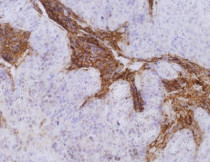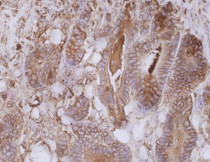ARG62915
anti-CD66e / CEA antibody [CB30]
anti-CD66e / CEA antibody [CB30] for Flow cytometry,IHC-Frozen sections,IHC-Formalin-fixed paraffin-embedded sections,Immunoprecipitation and Human
Cancer antibody; Developmental Biology antibody; Controls and Markers antibody; Microbiology and Infectious Disease antibody
Overview
| Product Description | Mouse Monoclonal antibody [CB30] recognizes CD66e / CEA |
|---|---|
| Tested Reactivity | Hu |
| Tested Application | FACS, IHC-Fr, IHC-P, IP |
| Specificity | The clone CB30 recognizes CD66e (CEA; 180-200 kDa), a cell surface bound carcinoembryonic antigen mainly expressed on epithelial cells. |
| Host | Mouse |
| Clonality | Monoclonal |
| Clone | CB30 |
| Isotype | IgG1 |
| Target Name | CD66e / CEA |
| Antigen Species | Human |
| Immunogen | Human carcinoembryonic antigen (CEA; CEACAM5) |
| Conjugation | Un-conjugated |
| Alternate Names | Carcinoembryonic antigen-related cell adhesion molecule 5; CEA; CD66e; CD antigen CD66e; Carcinoembryonic antigen; Meconium antigen 100 |
Application Instructions
| Application Suggestion |
|
||||||||||
|---|---|---|---|---|---|---|---|---|---|---|---|
| Application Note | IHC-P: Staining technique: Standard ABC technique (DAB+). Pretreatment: 0.1% pepsin in 0.1M HCl for 30 min at RT. * The dilutions indicate recommended starting dilutions and the optimal dilutions or concentrations should be determined by the scientist. |
||||||||||
| Positive Control | IHC-P: Adenocarcinoma of colon |
Properties
| Form | Liquid |
|---|---|
| Purification | Purified from hybridoma culture supernatant by protein-A affinity chromatography. |
| Purity | > 95% (by SDS-PAGE) |
| Buffer | PBS (pH 7.4) and 15 mM Sodium azide |
| Preservative | 15 mM Sodium azide |
| Concentration | 1 mg/ml |
| Storage Instruction | For continuous use, store undiluted antibody at 2-8°C for up to a week. For long-term storage, aliquot and store at -20°C or below. Storage in frost free freezers is not recommended. Avoid repeated freeze/thaw cycles. Suggest spin the vial prior to opening. The antibody solution should be gently mixed before use. |
| Note | For laboratory research only, not for drug, diagnostic or other use. |
Bioinformation
| Database Links |
Swiss-port # P06731 Human Carcinoembryonic antigen-related cell adhesion molecule 5 |
|---|---|
| Gene Symbol | CEACAM5 |
| Gene Full Name | carcinoembryonic antigen-related cell adhesion molecule 5 |
| Background | The CD66e (CEA; 180-200 kDa) is a member of carcinoembryonic antigens, immunoglobulin supergene family and consists of a single N domain (structural homology to the immunoglobulin variable) and six immunoglobulin constant-like A (A1, A2, A3) and B domains (B1, B2, B3). Human CD66e is heavily glycosylated GPI anchored protein capable of both homophilic and heterophilic adhesion. Disease relevance: The CD66e may play a role in the process of metastasis of cancer cells. CD66e is found in serum and it is clinically used as a tumor marker for early detection of disease due to its expression in adenocarcinomas - potential target of tumor imaging and drug targeting._x000D_ |
| Function | Cell surface glycoprotein that plays a role in cell adhesion and in intracellular signaling. Receptor for E.coli Dr adhesins. [UniProt] |
| Research Area | Cancer antibody; Developmental Biology antibody; Controls and Markers antibody; Microbiology and Infectious Disease antibody |
| Calculated MW | 77 kDa |
| PTM | Complex immunoreactive glycoprotein with a MW of 180 kDa comprising 60% carbohydrate. |
Images (2) Click the Picture to Zoom In
-
ARG62915 anti-CD66e / CEA antibody [CB30] IHC-P image
Immunohistochemistry: Colorectal carcinoma (paraffin-embedded sections) stained with ARG62915 anti-CD66e / CEA antibody [CB30].
-
ARG62915 anti-CD66e / CEA antibody [CB30] IHC-P image
Immunohistochemistry: Colorectal carcinoma (paraffin-embedded sections) stained with ARG62915 anti-CD66e / CEA antibody [CB30].
Clone References









